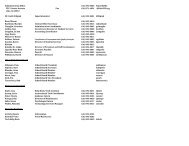You also want an ePaper? Increase the reach of your titles
YUMPU automatically turns print PDFs into web optimized ePapers that Google loves.
Protists Kingdom<br />
• Three major phylum (groups):<br />
Type Cell Type Organism Type Groups & Examples<br />
Funguslike<br />
Plant-like<br />
Animal-like<br />
known as:<br />
Protozoan<br />
Unicellular<br />
Unicellular,<br />
multicellular,<br />
and live in<br />
colonies<br />
Unicellular<br />
Decomposers. Fungus-like<br />
protists have cell walls and<br />
reproduce asexually by<br />
spores. All are able to move<br />
at some point in their lives.<br />
Producers. Live in soil, bark<br />
<strong>of</strong> trees, and fresh & salt<br />
water. Very important to the<br />
Earth because they produce a<br />
lot <strong>of</strong> oxygen and form the<br />
base <strong>of</strong> aquatic food chains.<br />
Consumers. All animal-like<br />
protists are able to move in<br />
their environment in order to<br />
find their food.<br />
3 Basic Groups:<br />
Water Molds,<br />
Downy Mildews,<br />
Slime Molds<br />
4 Basic Groups:<br />
Euglenoids, Din<strong>of</strong>lagellates,<br />
Diatoms, and<br />
Algae (Green, Red, and Brown)<br />
4 Basic Groups:<br />
Pseudopods - ex: Amoebas,<br />
Cilia - ex: Paramecium,<br />
Flagella - ex: Giardia,<br />
Others - ex: Plasmodium<br />
(Disease Causing)





